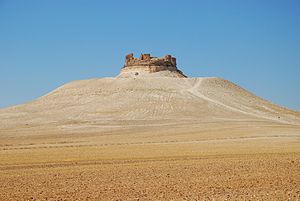Schmemis
| Schmemis Castle | ||
|---|---|---|
|
Harvested barley fields in autumn |
||
| Creation time : | 1230 | |
| Conservation status: | ruin | |
| Place: | Salamiyya | |
| Geographical location | 35 ° 2 '12.5 " N , 37 ° 0' 48.6" E | |
| Height: | 636 m | |
|
|
||
Schmemis , Arabic قلعة شميميس, DMG Qalʿat aš-Šamīmīs , also Shammasis, "sun castle"; is a ruined castle near Salamiyya in Syria , the visible remains of which date back to Ayyubid times.
location
Schmemis is located about 25 kilometers southeast of Hama on the edge of the Syrian desert steppe and rises on an old, 636 meter high volcanic cone about 150 meters above the plain. The castle ruins are 5 kilometers away from Salamiyya and can be reached from the end of the village in the direction of Hama on an asphalt side road that branches off to the north. The grain fields of the plain reach to the foot of the stony, vegetation-free hill. In the immediate vicinity there are some similar high ridges that are partially afforested.
history
The earliest excavation finds on the hill date back to the Bronze Age of the 14th century BC. Dated. In Roman times , foggaras were created to supply water.
Al-Salamiyah and the surrounding area was in the 8th century to around 900 the center of the Ismailis . In an earthquake in 1157, an earlier facility was destroyed. The castle was built around 1230 by the Ayyubid prince Malik al-Mujtahin Shirkuh of Homs . After several victories by the Ayyubid Sultan al-Salih against the Crusaders , he took possession of the castle in 1245. It was destroyed by the Mongols around 1260 . Baibars I , Sultan of the Mameluks from 1260 , took over the castle and ordered its reconstruction.
How long the castle retained its function is unclear. The area was hardly populated in the Middle Ages. In the 17th century, the Druze emir Fachr ad-Din II (ruled 1585–1633) extended his principality via Schmemis to Palmyra , where he also occupied the Mamluk fortress Qalʿat Ibn Maʿn there .
The area was not settled again until the middle of the 19th century when the Ottoman leadership allowed the Ismailis, who fled when the Mongols entered, to return. The starting point for the settlement of the castle ruins was a dispute that broke out in 1843 between the then governor of Masyaf in Jebel Ansariye and two renegade Ismailite leaders. A member of a prominent Sunni family was killed in the power struggle that took place in nearby Qadmus . One of the two rebels was caught and killed while he was fleeing, the other, Isma'il, withdrew to a mountain village. In 1847 or 1848 a commander of the Ottoman army granted Isma'il amnesty on the condition that he and his family retire to an area east of the Orontes . A document from the Ottoman Sultan Abdülmecid I from July 1849 is said to have allowed them to found a settlement on the edge of the desert and to arm 40 men to defend the place. The settlers were exempt from military service and taxes. Isma'il chose Salamiyya as the place of settlement. Most of the 90 or so emigrants from 16 families belonged to the Hajjawis , one of the two main groups of the Syrian Ismailis, who split off around the 16th century. At first they lived in the castle ruins, from where they began to plant arable land and to put the Roman Foggaras back into operation. They often had to protect their fields and flocks of sheep from raids by several Bedouin tribes. Although each settler had as much land as he wanted at their disposal, the colony only grew slowly until the end of the 19th century.
Castle complex
From a distance the vertical rock walls can be seen, below which a trench cut was created all around for defense. The walls were double- shelled from basalt blocks and filled with cast masonry inside . Only small remains of the outer fortress wall have survived. A special feature is a deep cistern shaft with a diameter of five meters, which was carved out of the rock in the southern, lower part.
Web links
- The medieval castles in Syria. Northern Syria and the Crusader Age. www.burgenfotos.de
- Basic plan of the castle ( Memento from February 14, 2007 in the Internet Archive )
Individual evidence
- ^ Norman N. Lewis: Nomads and settlers in Syria and Jordan, 1800–1980. Cambridge University Press, Cambridge 1987, pp. 60-62


